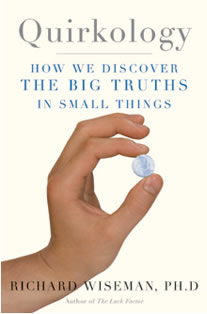The Colour-changing Card Trick
Seen by over 70 million people online and on television worldwide, The Colour-changing Card Trick is one of the most popular videos of recent years. Since user-created videos became one of the staples of the internet, Prof Wiseman has been thinking of ways to use the technology for science communication. The first of his creations, which can be viewed below, became an overnight hit, making it to the coveted number one Featured Video position on YouTube.
With a track record for reaching entirely new audiences, The Colour-changing Card Trick has become particularly popular among science educators as a fun way to communicate psychology.
DISCLAIMER: This video is copyright Richard Wiseman, all rights reserved. This video may not be used or re-created for any commercial purpose without permission, and may not be altered or edited for any purpose without permission.
BACKGROUND
The Colour-changing Card Trick illustrates a phenomenon known as change blindness. Research into this concept has been carried out by scientists since the 1970s, and examines why people are poor at detecting discrepancies between scenes in a film or two rapidly presented photographs. Some of the most creative work in this area has been produced by Dan Simons and his colleagues from the University of Illinois. Read about Dan Simons' work here.
Richard Wiseman discusses 'behind the scenes' at the filming:
"The plot of the card trick was carefully constructed to ensure that the
natural movement and focus of the close-up camera allowed opportunities
for the shirts, tablecloth and curtain to be changed when they are out
of shot. The piece required about 20 takes, and was tricky for several
reasons. First, Sarah and I had only a few seconds to change our tops
and get back into a stationary position before we came back into shot.
Second, the removal of the tablecloth happened just a few inches below
the bottom of the frame, and so any slight upward movement resulted in
my hand coming into shot. Third, the camera person had to both carefully
follow the action and secretly signal when we were out of shot. Fourth,
we all kept giggling.
The long shot was designed to show that the entire sequence was filmed
in one take, and did not involve any editing. Lots of people are curious
about the gorilla in the background – that is a nod towards a well-known
piece of footage created by created by Dan Simons and Chris Chabris to
investigate a related psychological phenomenon known as inattentional
blindness."
John
Henderson and Tim
Smith at Edinburgh University have recently used eye-tracking equipment
to explore why people are fooled by this video. Some of their initial
findings are illustrated in the clip below.


